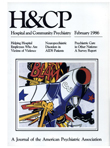A Study of Offenses Committed by Psychotic Inmates in a County Jail
Abstract
Following deinstitutionalization, several studies have documented an increase in the number of mentally ill inmates in prisons. The authors reviewed all referrals to a mental health clinic in a county prison and categorized each case as psychotic or nonpsychotic. The psychotic inmates were four times more likely to have been incarcerated for less serious charges such as disorderly conduct and threats, and they committed fewer sex offenses, property crimes, and drug offenses than nonpsychotic inmates. The authors conclude that the increased number of mentally ill prison inmates does not reflect a greater incidence of serious criminal activity in this group but an increase in the criminalization of psychotic behavior.
Access content
To read the fulltext, please use one of the options below to sign in or purchase access.- Personal login
- Institutional Login
- Sign in via OpenAthens
- Register for access
-
Please login/register if you wish to pair your device and check access availability.
Not a subscriber?
PsychiatryOnline subscription options offer access to the DSM-5 library, books, journals, CME, and patient resources. This all-in-one virtual library provides psychiatrists and mental health professionals with key resources for diagnosis, treatment, research, and professional development.
Need more help? PsychiatryOnline Customer Service may be reached by emailing [email protected] or by calling 800-368-5777 (in the U.S.) or 703-907-7322 (outside the U.S.).



